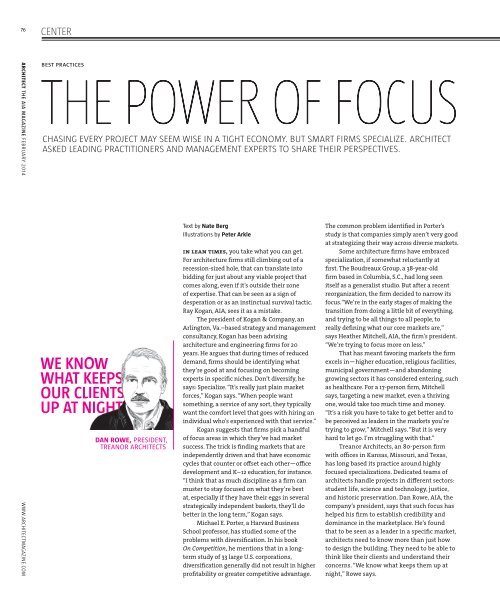Architect 2014-02.pdf
Create successful ePaper yourself
Turn your PDF publications into a flip-book with our unique Google optimized e-Paper software.
76<br />
CENTER<br />
ARCHITECT THE AIA MAGAZINE FEBRUARY <strong>2014</strong> WWW.ARCHITECTMAGAZINE.COM<br />
BEST PRACTICES<br />
THE POWER OF FOCUS<br />
CHASING EVERY PROJECT MAY SEEM WISE IN A TIGHT ECONOMY. BUT SMART FIRMS SPECIALIZE. ARCHITECT<br />
ASKED LEADING PRACTITIONERS AND MANAGEMENT EXPERTS TO SHARE THEIR PERSPECTIVES.<br />
WE KNOW<br />
WHAT KEEPS<br />
OUR CLIENTS<br />
UP AT NIGHT.<br />
DAN ROWE, PRESIDENT,<br />
TREANOR ARCHITECTS<br />
Text by Nate Berg<br />
Illustrations by Peter Arkle<br />
IN LEAN TIMES, you take what you can get.<br />
For architecture firms still climbing out of a<br />
recession-sized hole, that can translate into<br />
bidding for just about any viable project that<br />
comes along, even if it’s outside their zone<br />
of expertise. That can be seen as a sign of<br />
desperation or as an instinctual survival tactic.<br />
Ray Kogan, AIA, sees it as a mistake.<br />
The president of Kogan & Company, an<br />
Arlington, Va.–based strategy and management<br />
consultancy, Kogan has been advising<br />
architecture and engineering firms for 20<br />
years. He argues that during times of reduced<br />
demand, firms should be identifying what<br />
they’re good at and focusing on becoming<br />
experts in specific niches. Don’t diversify, he<br />
says: Specialize. “It’s really just plain market<br />
forces,” Kogan says. “When people want<br />
something, a service of any sort, they typically<br />
want the comfort level that goes with hiring an<br />
individual who’s experienced with that service.”<br />
Kogan suggests that firms pick a handful<br />
of focus areas in which they’ve had market<br />
success. The trick is finding markets that are<br />
independently driven and that have economic<br />
cycles that counter or offset each other—office<br />
development and K–12 education, for instance.<br />
“I think that as much discipline as a firm can<br />
muster to stay focused on what they’re best<br />
at, especially if they have their eggs in several<br />
strategically independent baskets, they’ll do<br />
better in the long term,” Kogan says.<br />
Michael E. Porter, a Harvard Business<br />
School professor, has studied some of the<br />
problems with diversification. In his book<br />
On Competition, he mentions that in a longterm<br />
study of 33 large U.S. corporations,<br />
diversification generally did not result in higher<br />
profitability or greater competitive advantage.<br />
The common problem identified in Porter’s<br />
study is that companies simply aren’t very good<br />
at strategizing their way across diverse markets.<br />
Some architecture firms have embraced<br />
specialization, if somewhat reluctantly at<br />
first. The Boudreaux Group, a 38-year-old<br />
firm based in Columbia, S.C., had long seen<br />
itself as a generalist studio. But after a recent<br />
reorganization, the firm decided to narrow its<br />
focus.“We’re in the early stages of making the<br />
transition from doing a little bit of everything,<br />
and trying to be all things to all people, to<br />
really defining what our core markets are,”<br />
says Heather Mitchell, AIA, the firm’s president.<br />
“We’re trying to focus more on less.”<br />
That has meant favoring markets the firm<br />
excels in—higher education, religious facilities,<br />
municipal government—and abandoning<br />
growing sectors it has considered entering, such<br />
as healthcare. For a 17-person firm, Mitchell<br />
says, targeting a new market, even a thriving<br />
one, would take too much time and money.<br />
“It’s a risk you have to take to get better and to<br />
be perceived as leaders in the markets you’re<br />
trying to grow,” Mitchell says. “But it is very<br />
hard to let go. I’m struggling with that.”<br />
Treanor <strong>Architect</strong>s, an 80-person firm<br />
with offices in Kansas, Missouri, and Texas,<br />
has long based its practice around highly<br />
focused specializations. Dedicated teams of<br />
architects handle projects in different sectors:<br />
student life, science and technology, justice,<br />
and historic preservation. Dan Rowe, AIA, the<br />
company’s president, says that such focus has<br />
helped his firm to establish credibility and<br />
dominance in the marketplace. He’s found<br />
that to be seen as a leader in a specific market,<br />
architects need to know more than just how<br />
to design the building. They need to be able to<br />
think like their clients and understand their<br />
concerns. “We know what keeps them up at<br />
night,” Rowe says.


















